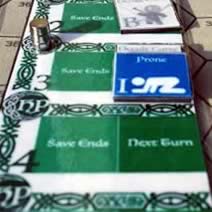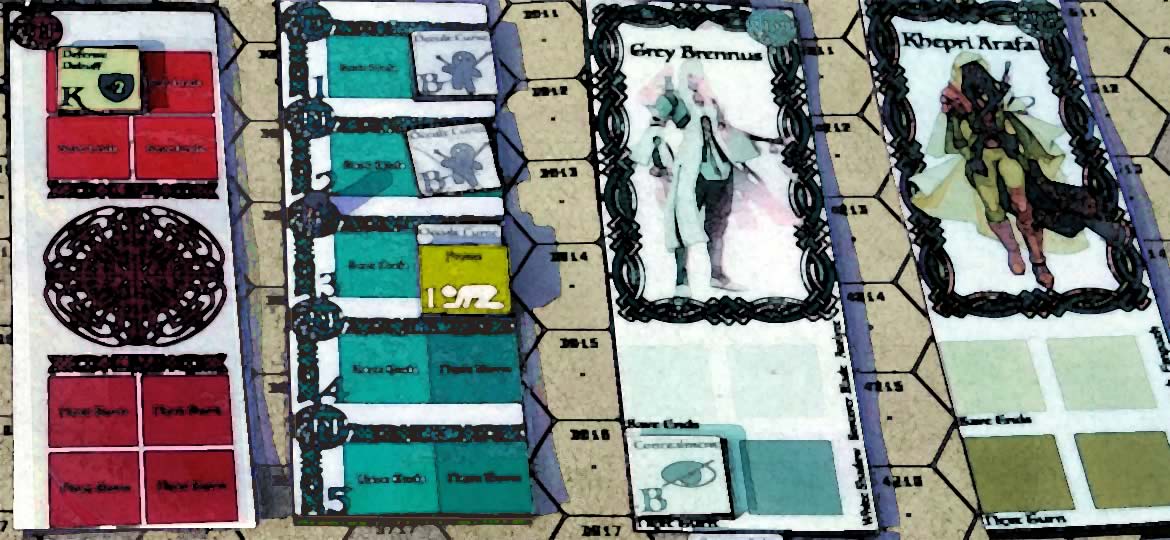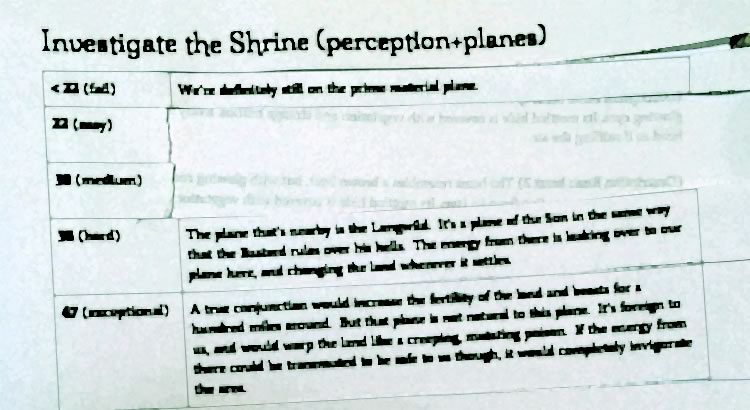My husband (who GMs with his own group) started using initiative cards first. The idea is straightforward. Use cards to represent each player turn and monster turn and put them in order of initiative when you are about to have an encounter (combat or otherwise) that has turns.
We have a big table – 4’x12′, so the cards need to be simple and easily understood from a distance. We use home made cards with very clear, large letter at the top to represent each player or NPC. Some monsters get multiple turns a round, so they get cards in a couple places. If there are a lot of monsters, like when you’re fighting groups of minions we well as their boss, the groups of monsters might use the same initiative card as a group. The player cards are colored on top and the NPC cards are all white. They look like this.

It’s just a printed out, cut out, and glued to cardstock. When it’s someone’s turn, the GM pushes the card up so that it sticks out from the rest of the row of cards. When their turn it done, he pushes it down and pushes up the next card.
It works well in practice. You can see exactly who’s going, who’s up next, when the monsters are about to have their turn, and it helps you plan out your tactics. As a player, you can see when your turn is about to be done, and you see his finger reach to push down that card, you have a chance to rush “Wait, wait, wait, I want to do one more thing!”
When I started GMing my recent campaign, I’d already used initiative cards as a player for years so I knew I’d continue using them as a GM.
Now, keep in mind. I know my strengths and weaknesses, and one of my biggest weaknesses as a GM is tracking the myriad details of combat while executing clever battle tactics. I’d hoped to minimize the number of times when the players complain “Oh my god, that monster just won’t die!” and I respond “Whoops, my bad. He was supposed to have died two turns ago, but I forgot to subtract the HP”. And I knew there would be times when one player would say she did a spell while another was asking me a question and I’d totally miss the spell part. So a turn later, she’d be all, “Wait, how did I get hit? That monster was blinded!” and I’d go “What? I mean, yes, of course, it TRIED to hit you. But it missed. Because of the blinding. That I totally knew about.”
Luckily one of my strengths is preparation. And arts and crafts. So I figured I could offload some of the tracking onto something I could make. Clearly, to me, the answer was to upgrade the simple initiative cards into something that also visually tracked HP and status conditions. But in a way could be interpreted from across a large table while read upside-down by players and that was quick for me to use.
No pressure or anything.
The fact that we needed something that could be read upside down cut out written solutions as a possibility. I know my handwriting, and it isn’t something that can be easily read even by trained cryptographers aided by state-of-the-art AI and battle-tested nurses. I needed some system of pre-made physical tokens to put on the cards, but I needed them to adhere to the cards in some way, otherwise every little jolt of the table or visit from the kiddos would reset our combat status.
After some brainstorming, I hit on the idea of magnets as a way of making the tokens stick to the initiative cards but making them easy to remove. But do they even sell magnets in a way that I can use them for cards and tokens? To the internet!
Come on, this is America. Of course they do.
I eventually settled on three types of magnets for new and improved deluxe initiative card system to work.
- A big card-stock-ish magnet that I can cut with my x-acto knife. This is the backing for the cards proper, which is just a paper printout. The NPC initiative cards are color coded to match the pawn holders that we used on the grid (red, yellow, blue, etc.) I made them two sided so that one side is for regular monsters, and the other is for minions and groups of monsters, with 5 short rows on them. For the PC cards, I used the picture of the character on it. Note, it’s not nearly as easy to read from a distance as the simple cards, but the cards are differentiable enough to use and they hold a lot more info. I ordered 4×6 peel-and-stick flexible magnetic sheets and then cut them in half for each card (so they’d be 2×6). I liked the form factor and the fact that they’re peel and stick and easy to cut, but the magnets were a little weak when I put a laminated card on top of them them, so I doubled them up and that seemed to fix the problem. When I do this again, I’ll either not laminate the card top or get stronger magnet sheets.
- A small, square magnet that I could use as a backing for the status tokens (for generic statuses like being blind, prone, or restrained as well as customized statuses like a defense buff or a sorcerer’s curse). I made sets for each character, and then a big ole bunch of them for the NPCs, with NPCs getting dark grey tokens and PCs getting tokens that matched their card colors. This way you know who put what status on who. On whom. Whatever. In any case, I ordered two sets of 100 4/5″ peel and stick squares. I love them, exactly what I wanted.
- And a tall round magnet that I could stack to indicate HP. After some consultation with the players, we came up with the following process. I put one little round magnet when the character is “injured”, in other words is more than 1/4 down on hit points. I stack a second magnet on top when it’s “bloodied”, or at least half down. And then I stack a third magnet on top when it’s “critical” or at least 3/4 down. When the character is dead/unconscious/out of the fight, I flip the card over or cover it up with much fanfare. I ordered little round silver magnets, and what I got was not at all what I expected. They’re both teensy tiny and super strong. It was my fault for not reading the description better, but I definitely was picturing something wider, and people with big fingers may have trouble manipulating them.
Here’s what it looks like after I print out fronts for the cards and stuck them to the magnets:

Here’s a close up of one of the NPC cards.

You can see the little round silver magnets stacked three high hear the top left. Despite their tinyness, this works well enough for now. Actually, the stacked health magnets were the biggest hit of the change, I think. It lets the healer and defenders know who’s in trouble at a glance. And you would not believe the baited breath each time someone hits boss while the players wait to see whether a little magnet goes on. They’re small yet mighty.
It’s still a work in progress. I’d like for them to be as readable as the old initiative cards while still packing the extra info AND having cool style. Maybe in the next iteration. And I like adding colors, but if we played with someone that is color blind, we’d need a different way to differentiate things clearly. But the biggest unsolved problem for me is how to gracefully store the unused tokens during play so they’re ready to use as soon as a character needs them, but where they don’t take up any of my precious GM space. The best solution I’ve thought of so far is maybe using a magnetic knife holder as a token holder. Maybe.
In any case, visit my Tools page if you want to print your own simple initiative cards. I’ll try to add a token printer to it, too.



I love this. The assets you are generating are fantastic. Can’t wait to catch up on the rest of your posts.
These are wonderful. As a visual person, I can’t believe what a difference having my character artwork on the initiative card makes. It really feels like it’s “my turn in the spotlight” when you bump my card up.
Also, the magnetic system is excellent! It makes me wonder how I as player might be able to leverage something similar.